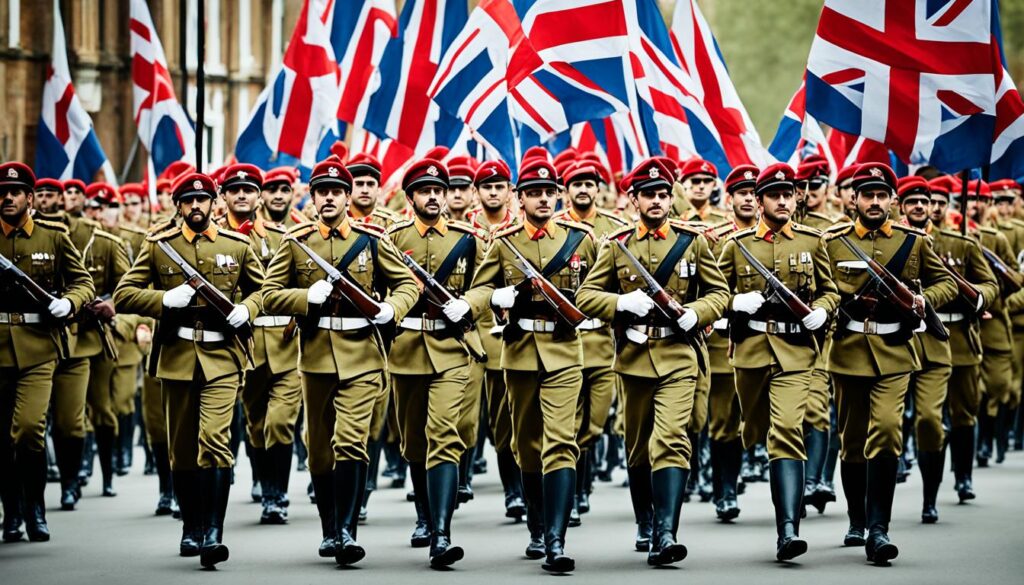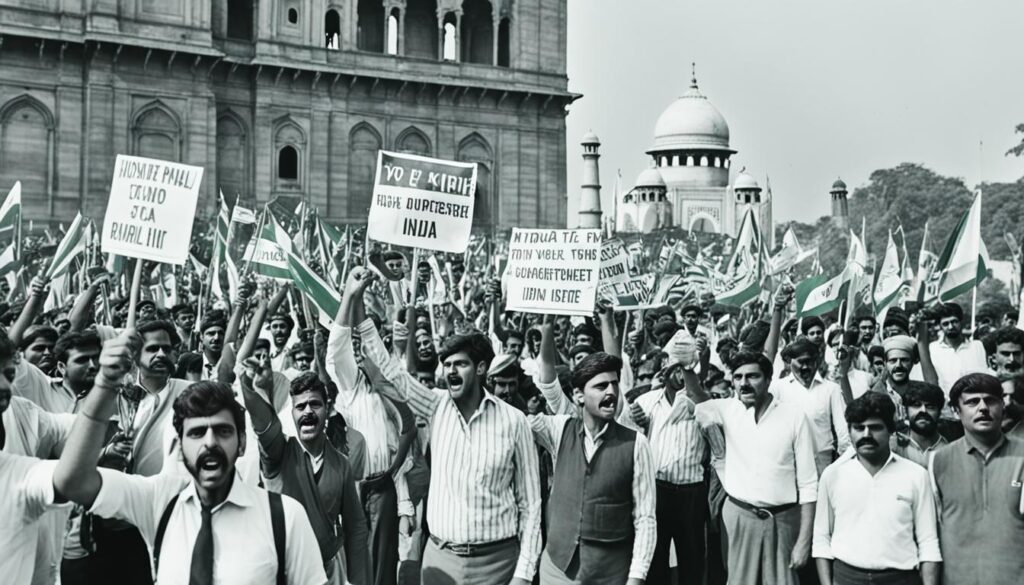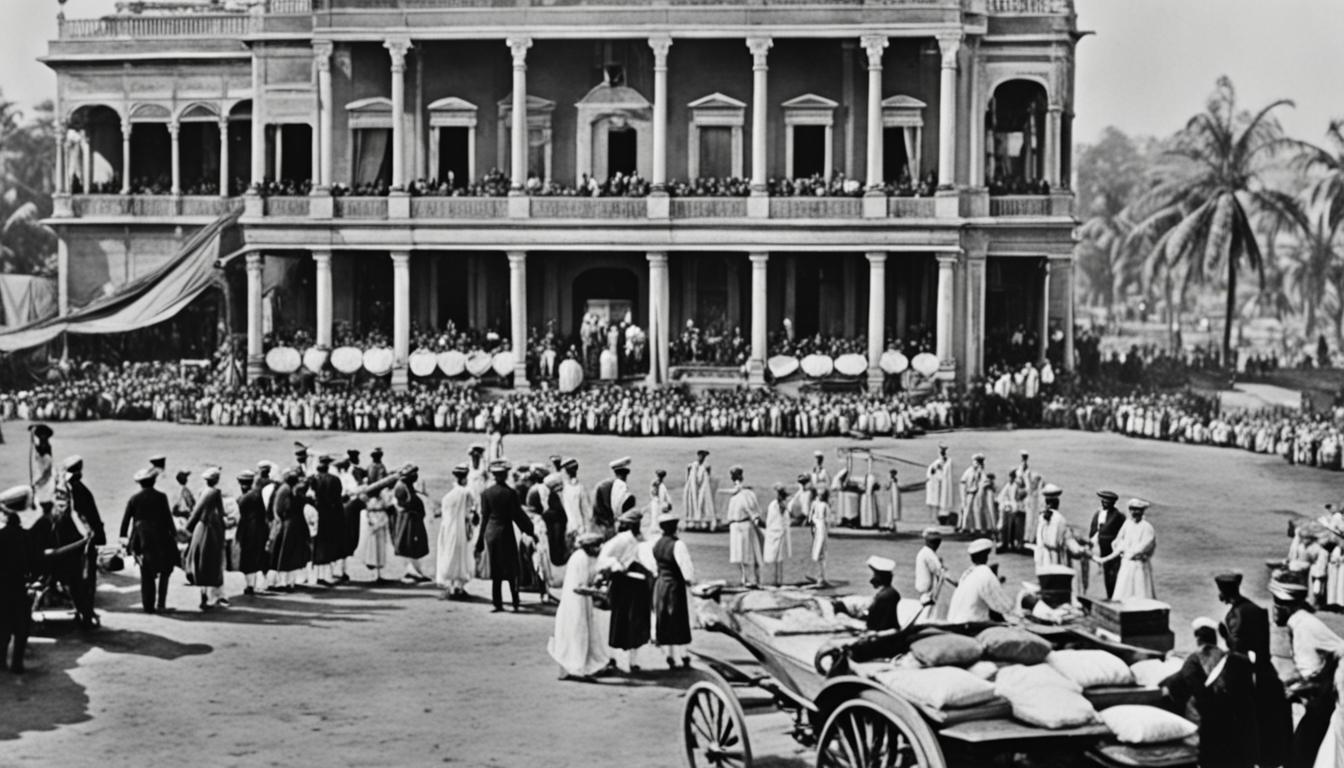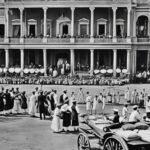What if the British Raj in India wasn’t as smooth and victorious as we thought? Exploring its history reveals a different side. It wasn’t just about British power and order. Instead, a tale of complexity and disorder emerges.1
From the famous Sepoy Mutiny in 1857 to India and Pakistan gaining independence in 1947, the British Raj faced many challenges. These included rebellions, movements for freedom, and struggles to rule a vast, varied land.1
Key Takeaways
- The British Raj, a period of direct British rule in India, lasted from 1858 to 1947.
- The Sepoy Mutiny of 1857 led the British government to take direct control of India from the East India Company.
- The British Raj faced growing demands for Indian independence, fueled by a rising nationalist movement.
- The partition of India and Pakistan in 1947 resulted in massive displacement and violence.
- The legacy of the British Raj continues to shape India’s legal system, culture, and society.
The Rise of the British East India Company
Europeans treasured trade with India for centuries. The voyage’s obstacles included dangerous passages and the expenses added by middlemen.2 The British decided to handle Indian trade differently by setting up the East India Company. This company first started operations in India. It got special rights to own land, secure its posts, and trade without taxes, thanks to deals with local leaders.2
Early Trade and Fortified Posts
In 1600, the East India Company began in England. It managed vast parts of India from 1757 to 1858.2 Its rule grew stronger after battles that ended with victory over its European rivals. In 1757, it placed a ruler friendly to it in Bengal.2
Territorial Expansion and Conquest
From 1757 to 1858, the company fought wars and formed agreements that enlarged its control over India.1 The Indian uprising in 1857 led to the end of the company’s control.1 The British government then took over directing India.1
Subjugation of the Indian Subcontinent
By 1858, the East India Company or its allies governed much of what’s now India, Pakistan, and Bangladesh.3 This venture lasted 274 years, greatly impacting global trade and politics.3 At its height, the company had a larger military than the United Kingdom itself.3 It monopolized much of the world’s commerce from the 1700s to the 1800s.3
The East India Company focused on trading cotton, silk, and various other goods.3 In 1874, it ceased operations due to changes in India’s administration.3 The British government took direct control following the events of 1858.3
The Sepoy Mutiny of 1857
On March 29, 1857, Mangal Pandey, a sepoy, attacked British officers at a garrison. This sparked the4 Sepoy Mutiny. It soon spread across northern India.5
Mangal Pandey’s Revolt
Mangal Pandey’s attack started the4 Sepoy Mutiny against the East India Company. Indian sepoys, the majority in the6 Bengal Army, were upset over missteps by the British. This led to a deepening anger.
Their frustration with cultural and religious insults made them turn against their British superiors.5
Seizure of Delhi
In4 Delhi, the mutineers took charge. It became the main center for the uprising across northern India. Capturing Delhi was critical. It gave the rebels a strategic base.
This move helped them gather more fighters and plan against the British. They started to find strength together.
Aftermath and Consequences
The4 Sepoy Mutiny finally stopped on July 8, 1859. It lasted over a year. After this, the British completely took over India. They ruled directly, without the East India Company.
This change also reformed the British Indian Army. It started to include more communities. The goal was to ensure more loyalty.6
Establishment of the British Raj
The1 Government of India Act of 1858 marked the start of direct British raj rule over India. This followed the2 1857 Indian Mutiny. During this event,2 sepoy troops rebelled against their British officers.
This rebellion led to the end of the East India Company’s rule. Power then moved from the company to the British crown.1 The remaining authority of the company was placed in the hands of the secretary of state for India. This person, part of the British cabinet, led the India Office in London. They got advice from a Council of India, especially on financial matters.
Queen Victoria’s Proclamation
Lord Canning made an announcement on November 1, 1858. He shared7 Queen Victoria’s message with “the Princes, Chiefs and Peoples of India.” This message unveiled a new British approach. The policy promised never-ending help for “native princes” and nonintervention in religious matters in British India.
This change in policy, known as noninterference in religious beliefs, began in 1858. It signified a shift from expanding British influence through annexations.
Social and Administrative Policies

Many Britons feared more uprisings after the 1857 mutiny. They thought these fights started when Hindu and Muslim people resisted the changes brought by British official policies1. These policies included using less religion in government decisions and trying to win more people over to the Christian faith.
Around 1867, the military was changed to have more Britons than Indians. Before, there were armies in places like Bengal, Bombay, and Madras with different numbers of British and Indian soldiers. They made this new mix to prevent more uprisings1.
Reorganization of the British Indian Army
After the 1857 mutiny, the British Indian Army had a big overhaul. The British officials who worked in India during this time saw their job as caring for the Indian people. They did this by leading very separate lives from them1.
They lived like elite government workers, known as “Pukka Sahibs.” They spent time in exclusive clubs and military areas, far from the local people. This created a clear gap between the British and those they ruled, making the Indians want their freedom even more1.
The “Steel Frame” of British Rule
The British Indian Civil Service was key in keeping control over India for the British. These officials, known as the “Steel Frame,” stayed away from the local culture8. They thought they were superior and kept to themselves. This made Indians against the British feel even more apart. It helped fuel the desire for India to be free8.
The British raj and Its Chaos
Historian Jon Wilson explains that the British empire in India was not what it seemed. It was not united or in control. And it was not sure of its purpose, despite its boasting.9 He says it was more about fears and disorder than any solid plan.9 The British glorified their victories but overlooked the messy reality behind them. Wilson adds that the changes the British brought did not always help make things better. Instead of bringing stability, their actions often led to confusion.9 They replaced local ways of doing things with distant rules. This shift didn’t always work well.
Contingency and Indecision
The rule of the British in India was known more for its disorder than any clear direction.9 It was not about a carefully planned strategy. Instead, it was a mix of last-minute choices and responses to problems.9 Because of this, British control in India was never strong or steady.9
Lack of Coherent Vision
The British rulers in India did not have a steady vision for what the future should be.9 They often made decisions based on what worked for now, rather than what made sense for the long run.9 This short-term thinking added to the confusion and doubt of the British rule. With an increasing desire for freedom among Indians, their control began to slip.
Rapacity and Stupidity
On top of the lacking direction and the chaotic decisions, there was also greed and foolishness within the British officials.9 They were focused on gaining wealth and power, often forgetting about the well-being of the local people. Their poorly thought policies only made things worse.9 This mix of selfishness, a lack of foresight, and bad leadership helped bring the end to the British presence in India.9
Legacy and Influence of British Laws
India’s legal system has deep ties to its colonial history. The British put in place many laws, like the Indian Penal Code (IPC) and the Indian Evidence Act. These are still very important in Indian law today.10 After getting independence, India made sure to keep a stable legal system. This meant keeping a lot of the British laws.10 Even though these laws came from colonial times, they are now a big part of Indian legal culture. It’s hard to make big changes without causing problems.10
Continuity and Stability
Keeping the old British laws has helped India stay stable and continuous after becoming independent.10 India has been able to update its laws over time. But, it has kept the main structure from the colonial period.10
Pragmatic Considerations
Changing the legal system completely is a huge challenge. India is taking a smart step-by-step approach. It changes or gets rid of certain laws, rather than all at once.10 This way, India’s laws can keep up with modern times and reflect what’s important to its people. But it stays stable and without sudden big disruptions.10
Quest for Legal Modernization
India still reflects its colonial past in its11 legal system but is pushing for modernization. The country is updating old laws and ensuring justice for everyone. It’s also aligning its laws with global11 standards. This effort involves a lot of discussion, research, and teamwork between legal experts, policymakers, and the public. Indian laws are changing to deal with issues like cybercrime, protecting the environment, and promoting gender equality. Yet, they are staying true to basic justice principles.
The British rule in India had a big influence on the country’s12 legal framework. Many old laws are still used today. But, India is moving forward with legal reform. The government and legal professionals are striving to update the12 Indian legal system for the modern age. They carefully consider India’s past and are changing laws in a balanced way. This aims to keep things stable while making positive changes.
| Key Aspects of Legal Modernization in India | Initiatives and Outcomes |
|---|---|
| Updating Archaic Legislation | Repealing or amending outdated laws that no longer align with modern societal needs and values. This includes reviewing and revising legislation related to areas such as criminal justice, personal laws, and commercial regulations. |
| Ensuring Access to Justice for All | Expanding legal aid services, enhancing alternative dispute resolution mechanisms, and improving the efficiency and transparency of the judiciary to make the justice system more accessible and equitable for all citizens. |
| Adapting to Global Legal Standards | Aligning Indian laws and regulations with international best practices and emerging global frameworks, particularly in areas such as environmental protection, intellectual property rights, and cross-border commercial transactions. |
India is dedicated to the ongoing process of legal modernization. This shows its desire to upgrade its legal system to meet the world’s fast changes. By keeping the heart of the legal system but also responding to new challenges, India wants its12 legal system to be valuable, efficient, and meet the hopes of its people.
The Indian Independence Movement

Indians couldn’t shape their future without British approval. This led to a strong drive for independence. The movement saw the birth of Indian nationalism, Gandhi’s peaceful protests, and the Quit India Movement.13,14
Rise of Indian Nationalism
In the early 20th century, Indians sought self-rule more aggressively.14 Mahatma Gandhi began leading in the 1920s. He chose non-violence and breaking unjust laws as the way forward.14 Women like Sarojini Naidu and Vijaya Lakshmi Pandit also stood up. They fought for equal rights for Indian women in the freedom movement.14
Gandhi’s Non-Violent Resistance
Gandhi protested against British rule in two famous events. These were the Non-Cooperation Movement and the Salt March.13 By the 1930s, the independence movement turned towards socialism.14
Quit India Movement
In 1942, Gandhi launched the Quit India Movement. Its goal was to end British control.13 The push for independence finally succeeded in 1947. This was when the Indian Independence Act was passed.14 India and Pakistan both formed. They were free nations, with India gaining independence on August 15th and Pakistan on the 14th. This was due to the area’s partition.13
Partition of India and Pakistan
In 1947, the British raj ended, and the Indian subcontinent was divided. It became India and Pakistan. A new border, the Radcliffe Line, was drawn by a special group. It separated areas by religion, giving most Muslim territories to Pakistan.15 This change led to a lot of people moving and a lot of violence. Many had to leave their homes, and some even died.15
The Radcliffe Line
The Radcliffe Line, after Sir Cyril Radcliffe, marked where India ended and some Muslim areas became Pakistan.15 Pakistan got districts in Punjab and Bengal with many Muslims. India got areas where most people were Hindu.15
Displacement and Violence
The partition caused a huge movement of people. About 10-20 million had to find new places to live.15 Sadly, almost 1 million died in the violence that followed. Many more people than expected died during this time.15 Between 14 and 18 million people moved as refugees.15
Impact and Consequences of the British raj
The British raj deeply changed India’s economy and society. It also influenced its culture and language.18 New ways of governing, building, and trading reshaped India.
Economic and Social Changes
Under the British raj, India saw its economy grow in new ways. Railways, telegraphs, and ports started appearing.8 They connected India to the world’s trade, changing how it did business.1
Besides, there were big social shifts. For example, the British made a law in 1891 that raised the legal marriage age for girls.1 This change protected young Indian brides more.
Cultural and Linguistic Influences
Not just in money and laws, the British raj also impacted India’s culture and language.8 British rule brought negative views of native Indians, but India picked up some British traditions too.8
Today, we see the British raj’s influence all over India. In laws, buildings, and in how widely English is spoken.
Conclusion
The British raj in India brought both good and bad.1 New forms of governance and infrastructure came with it. But, there were also big problems like the Sepoy Mutiny in 1857.1 The Indian people wanted their independence. This struggle still affects India today.16 India’s legal system, culture, and society all show this influence.
The British rule in India went on from 1858 to 1947.1 The Government of India Act of 1858 changed power from the East India Company to the British Crown.1 Queen Victoria became Empress of India in 1876.1 Over 560 enclaves were under British control.1 The effects of the British raj continue to impact India. This is seen in its laws, culture, and society, even today.
The British raj in India was a mix of progress and problems.16 As India grows, it carries forward its history, including the time of British rule. This era is still key to India’s story and future.
FAQ
What was the British Raj?
The British Raj was a direct rule by Britain over the Indian subcontinent from 1858 to 1947. It followed the rule by the British East India Company.
How did the British East India Company establish control in India?
The East India Company gained a foothold in India through local permissions. They were allowed to own land, protect their interests, and trade without taxes. Gradually, through conflicts, treaties, and takeovers, they extended their power across India.
What led to the Sepoy Mutiny of 1857?
The Sepoy Mutiny began with a sepoy named Mangal Pandey attacking British officers at Barrackpore. This led to a wide rebellion across northern India, with Delhi becoming the central point of the mutiny.
How did the British government respond to the Sepoy Mutiny?
The revolt led to the end of the East India Company’s rule. Power was shifted to the British Crown. The Government of India Act in 1858 marked the formation of the British Raj. It placed control under the secretary of state for India.
What were the social and administrative policies of the British Raj?
The British Raj aimed at not interfering in religion. They restructured the Indian Army and promoted a “Steel Frame” of British officers. These officials were encouraged to stay separate from Indian influence in their leisure spots and camps.
How was the British Raj viewed by historians?
Historians like Jon Wilson argue that the British empire in India was not strong or unified as it thought. The changes made by the British fell short of bringing lasting peace. They sidelined local traditions for their remote laws.
How did the British Raj influence India’s legal system?
The British brought many laws, such as the Indian Penal Code and the Indian Evidence Act, which are still in use. These laws, although from a colonial past, have deeply impacted India’s legal system. Changing them is now a meticulous task.
What was the Indian independence movement?
Indians sought self-rule as British control grew tight. This desire for independence sparked the Indian nationalism movement. It included Gandhi’s peaceful protests and the Quit India Movement. Finally, in 1947, India became independent from the British.
What was the impact of the partition of India and Pakistan?
The end of British rule marked the division of India and Pakistan in 1947. The border, called the Radcliffe Line, was drawn along religious lines. This caused a mass exodus and violence as people moved to their new countries.
What was the lasting impact of the British Raj on India?
The legacy of the British Raj on India is deep. It shaped the country’s economy, society, culture, and more. Today, India is still dealing with the effects of British rule as it strives for modernization and change.
Source Links
- https://www.britannica.com/event/British-raj
- https://www.bbc.co.uk/bitesize/articles/zx8sf82
- https://en.wikipedia.org/wiki/East_India_Company
- https://www.britannica.com/event/Indian-Mutiny
- https://www.nam.ac.uk/explore/why-did-indian-mutiny-happen
- https://en.wikipedia.org/wiki/Indian_Rebellion_of_1857
- https://en.wikipedia.org/wiki/British_Raj
- https://www.asianstudies.org/publications/eaa/archives/the-british-impact-on-india-1700-1900/
- https://www.historytoday.com/reviews/britain’s-raj-and-chaos-empire
- https://www.linkedin.com/pulse/legacy-british-laws-india-unraveling-historical-framework-sajad-
- https://crimsonpublishers.com/cojrr/fulltext/COJRR.000519.php
- https://blogs.lse.ac.uk/humanrights/2023/07/12/beyond-the-raj-how-british-colonialism-continues-to-impact-human-rights-in-india/
- https://education.nationalgeographic.org/resource/indias-independence/
- https://en.wikipedia.org/wiki/Indian_independence_movement
- https://en.wikipedia.org/wiki/Partition_of_India
- https://academic.oup.com/book/12148/chapter/161570824

